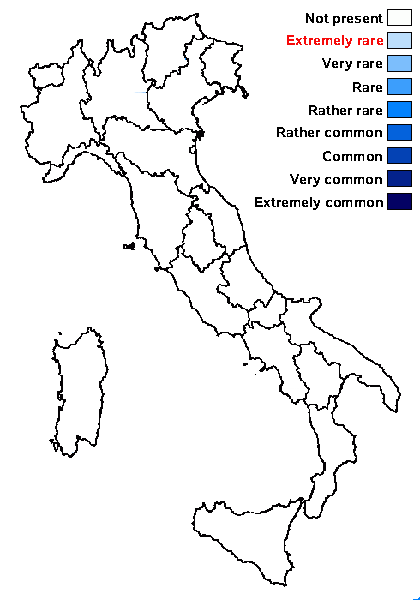Lepraria atlantica Orange
Lichenologist, 33: 462, 2001
Synonyms:
Distribution:
Description: Thallus leprose, powdery, usually diffuse (never lobed), pale bluish grey, sometimes whitish or very pale grey-cream, entirely consisting in a soft, almost cottony mass of 40-100(160-220) µm wide, soredia-like granules; projecting hyphae rarely present, short; consoredia rare: hypothallus present in patches, of usually sparse, white to dull orange hyphae. Photobiont chlorococcoid. Spot tests: K- or K+ pale yellow, C-, KC- or KC+ yellow, P- or P+ pale yellow, UV-; hypothalline orange patches K+ purple-red. Chemistry: the two most common chemotypes contain 1) atranorin, porphyrilic acid and accessories, rangiformic acid; 2) atranorin, porphyrilic acid and accessories, roccellic/angardianic acid; rarer chemotypes contain: 3) porphyrilic acid and accessories only, and, 4) fatty acids (rangiformic and roccellic/angardianic acids), atranorin and porphyrilic acid. The hypothalline hyphae usually produce unidentified anthraquinones. Note: a widespread species with a still unclear distribution pattern in Europe, growing on acidic rocks and soil, often over bryophytes, on surfaces more or less sheltered from rain; reported from the Swiss Alps, to be looked for in Italy
Growth form: Leprose
Substrata: rocks, soil, terricolous mosses, and plant debris
Photobiont: green algae other than Trentepohlia
Reproductive strategy: mainly asexual, by soredia, or soredia-like structures (e.g. blastidia)
In underhangs rarely wetted by rain

Predictive model
Growth form: Leprose
Substrata: rocks, soil, terricolous mosses, and plant debris
Photobiont: green algae other than Trentepohlia
Reproductive strategy: mainly asexual, by soredia, or soredia-like structures (e.g. blastidia)
In underhangs rarely wetted by rain

Predictive model

